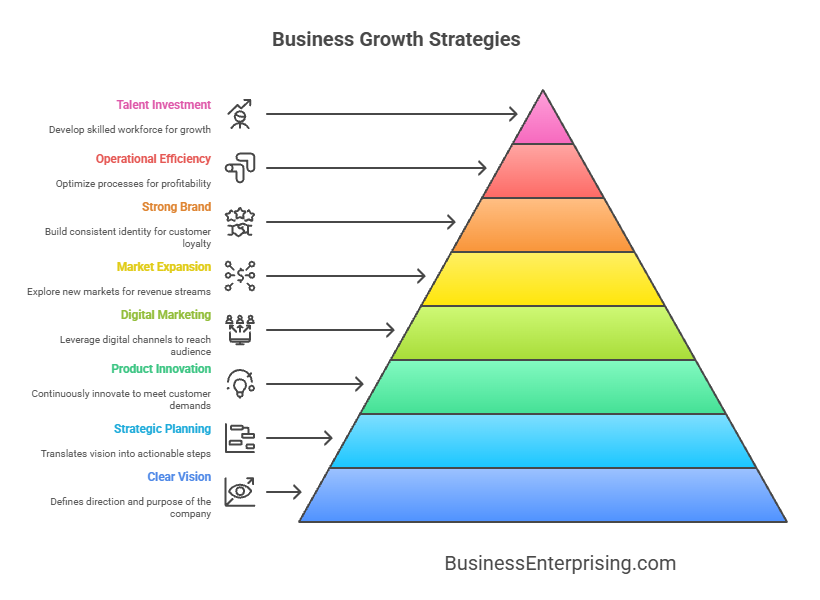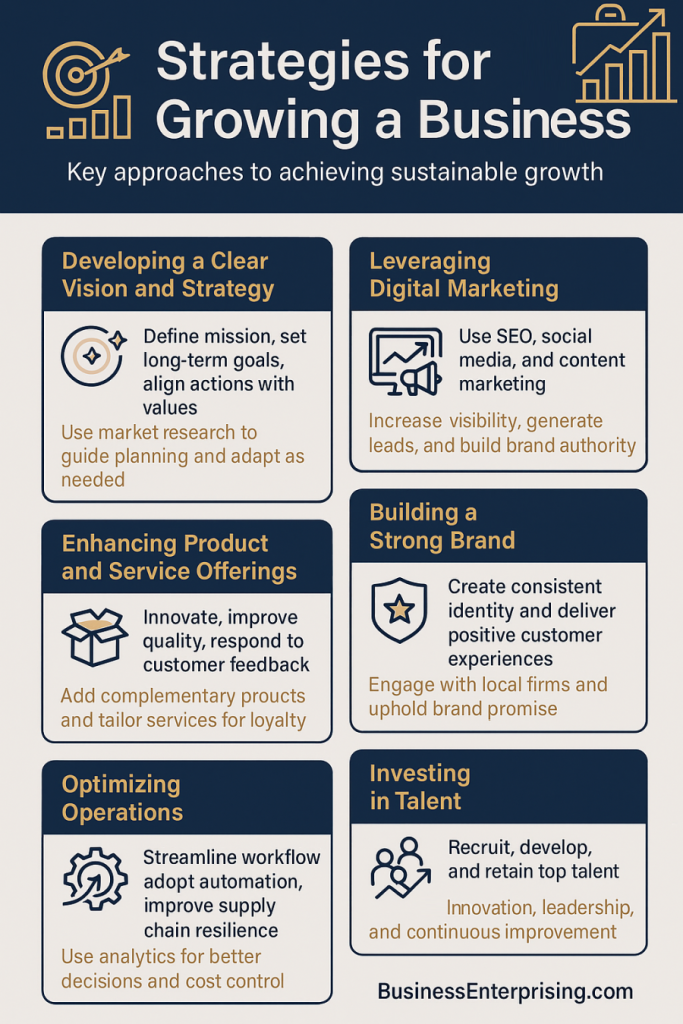
Developing a Clear Vision and Strategy
A clear vision is the cornerstone of business growth, and therefore it serves as the foundation for all strategic efforts. It not only defines the direction and purpose of the company but also guides decision-making and strategic planning. Furthermore, businesses must articulate their long-term goals and objectives, ensuring that they consistently align with the company’s mission and values. As a result, a well-defined vision provides a roadmap for growth, helping the business remain focused and motivated over time.
Additionally, strategic planning is crucial for translating the vision into actionable steps that drive measurable results. To begin, companies should conduct thorough market research so they can better understand industry trends, customer needs, and competitive dynamics. Consequently, this information can inform the development of a comprehensive growth strategy that outlines specific goals, target markets, and the resources required to achieve them. Moreover, a strategic plan should remain flexible, allowing the business to adapt to changing circumstances and, in turn, seize new opportunities for expansion.
Enhancing Product and Service Offerings
Strategies for growing a business include improving product and service. Companies must continuously innovate to meet evolving customer demands and differentiate themselves from competitors. This involves investing in research and also development to create new products or enhance existing ones. Businesses should actively seek customer feedback to identify pain points and areas for improvement.
Introducing complementary products or services can also boost revenue and attract new customers. Companies should explore opportunities to diversify their offerings, leveraging their core competencies to enter new markets. Additionally, implementing a customer-centric approach can also enhance the overall value proposition, increasing customer satisfaction and loyalty. Personalized experiences, tailored recommendations, and responsive customer service are essential components of a customer-centric strategy.
Leveraging Digital Marketing
Digital marketing is a powerful tool for reaching a wider audience and driving business growth. Companies should leverage various digital channels, including social media, email marketing, search engine optimization (SEO), and content marketing, to engage with potential customers. A well-executed digital marketing strategy can increase brand visibility, generate leads, and convert prospects into loyal customers.
Social media platforms provide an excellent opportunity to connect with customers and build brand awareness. Companies should create engaging content that resonates with their target audience, encouraging interaction and sharing. Additionally, paid advertising on social media can also enhance reach and also drive targeted traffic to the company’s website.
SEO is another critical aspect of digital marketing. By optimizing their website for search engines, businesses can improve their organic search rankings and attract more visitors. This involves conducting keyword research, creating high-quality content, and building backlinks. An effective SEO strategy can increase online visibility as well as drive sustainable traffic to the company’s website.
Expanding to New Markets
Among the top strategies for growing a business is expanding to new markets which can open up new revenue streams and diversify risk. Companies should conduct thorough market research to identify potential markets and assess their viability. This involves analyzing market size, growth potential, competitive landscape, and regulatory environment. A well-planned market entry strategy can help businesses navigate the complexities of international expansion and achieve success.
Companies can explore various market entry modes, including exporting, licensing, franchising, joint ventures, and wholly-owned subsidiaries. Each mode has its advantages and risks, and businesses must choose the one that aligns with their strategic goals and resources. Partnering with local firms can provide valuable market insights and facilitate a smoother entry.
Additionally, adapting products and services to meet local preferences and cultural nuances is also crucial for success in new markets. Businesses should tailor their marketing and sales strategies to resonate with local customers, ensuring that they address their specific needs and preferences.
Building a Strong Brand
A strong brand is a valuable asset that can drive business growth by enhancing customer loyalty and attracting new customers. Companies should invest in building a consistent and recognizable brand identity that reflects their values and resonates with their target audience. This involves creating a compelling brand story, designing a memorable logo, and maintaining a consistent visual identity across all touchpoints.
Effective branding goes beyond visual elements. It encompasses the overall customer experience, from the quality of products and services to the tone of communication and customer service. Companies should strive to create positive and memorable experiences that reinforce their brand promise. Engaging with customers on social media, responding to feedback, and demonstrating social responsibility can strengthen the brand as well as build trust.
Optimizing Operations
Operational efficiency is critical for supporting business growth and maintaining profitability. Companies should continuously evaluate their processes and systems to identify areas for improvement. Implementing best practices, streamlining workflows, and adopting automation can enhance productivity and reduce costs.
Technology plays a pivotal role in optimizing operations. Businesses should leverage advanced tools and software to manage inventory, track performance, and facilitate communication. Enterprise resource planning (ERP) systems can integrate various functions, providing real-time visibility and improving decision-making. Additionally, data analytics can also offer valuable insights into operational performance, helping businesses make informed decisions and drive continuous improvement.
Supply chain management is another crucial aspect of operational efficiency. Companies should work closely with suppliers to ensure timely delivery of materials and products. Implementing effective inventory management practices can minimize stockouts and reduce holding costs. Building a resilient supply chain that can adapt to disruptions is essential for sustaining growth.
Investing in Talent
A skilled and motivated workforce is essential for driving business growth. Companies should invest in attracting, developing, and retaining top talent. This involves creating a positive work environment that fosters collaboration, innovation, and professional growth. Offering competitive compensation and benefits, providing opportunities for training and development, as well as recognizing employee achievements can enhance employee satisfaction and loyalty.
Leadership development is also crucial for supporting growth. Companies should identify and nurture future leaders who can drive the organization forward. Providing mentorship, coaching, and leadership training can equip employees with the skills and confidence to take on leadership roles.
Additionally, fostering a culture of continuous improvement and innovation can also empower employees to contribute to the company’s growth. Encouraging employees to share ideas, take initiative, and embrace change can drive innovation and enhance overall performance.
Conclusion
Growing a business requires a strategic and holistic approach that encompasses vision, innovation, marketing, market expansion, branding, operational efficiency, and talent management. By developing a clear vision and strategy, enhancing product and service offerings, leveraging digital marketing, expanding to new markets, building a strong brand, optimizing operations, as well as investing in talent, companies can achieve sustained growth and success.
In conclusion, business growth is a multifaceted journey that demands careful planning, execution, and adaptability. Companies that prioritize strategies for growing a business are better positioned to navigate the complexities of growth and achieve their long-term objectives. As the business landscape continues to evolve, staying agile and committed to continuous improvement will be crucial for maintaining a competitive edge and driving sustained success.


